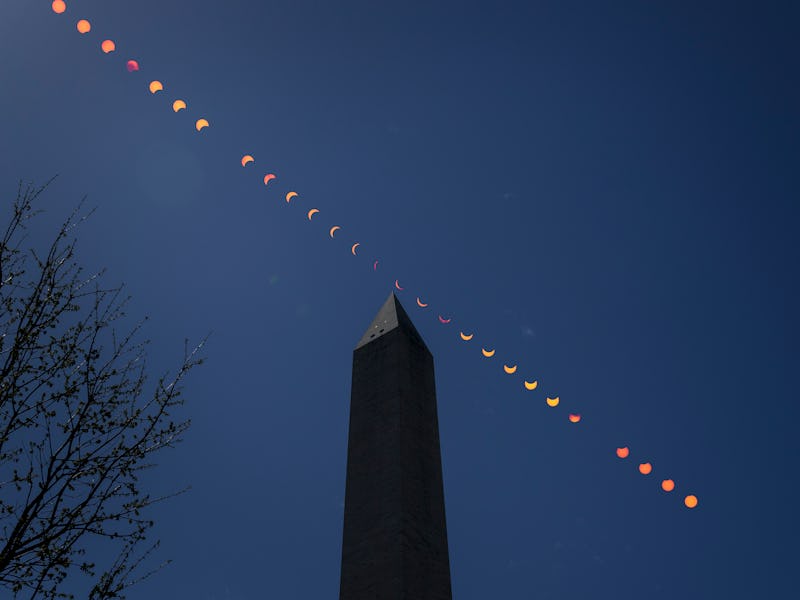9 Totally Stellar Images From April 8’s Solar Eclipse
In case you missed it — or just couldn’t get enough — here are the best images of the 2024 total solar eclipse.

Millions of people spent yesterday afternoon looking up at the sky, watching as our planet’s orbit brought the Moon and the Sun into perfect alignment in the midday sky. For a few minutes, the Moon’s dark silhouette covered the Sun, plunging the ground below into chilly darkness across a narrow swath of North America. The next chance for most people in the U.S. to witness totality again won’t come for abother 20 years; to tide you over, here are the best eclipse photos from across — and high above — North America.
The View From Above
From its vantage point more than 22,000 miles above the Americas, the European Space Agency's GOES-16 satellite watched the dark shadow of the Moon move swiftly across the continent from Mexico to Newfoundland. GOES-16, formally called the Geostationary Operational Environmental Satellite, monitors Earth's atmosphere and space weather. NASA and the U.S. National Oceanic and Atmospheric Administration (NOAA) work with ESA on the project.
GOES-16 tracked the eclipse as it crossed North America.
ESA’s Copernicus-Sentinel 3 spacecraft caught a snapshot of the moon’s shadow darkening an area of the Pacific Ocean just before it crossed the west coast of Mexico.
The Copernicus satellite monitors large-scale changes in Earth’s atmosphere.
One of SpaceX’s Starlink satellites also caught a short video of the eclipse, which the company shared on Twitter (now called X).
SpaceX’s fleet of around 5,500 Starlink satellites orbit between 210 and 380 miles above Earth’s surface, frequently vexing astronomers.
Astronauts aboard the International Space Station, 250 miles above the ground, also had a great view of the Moon’s shadow moving northeast across a narrow swath of North America. Note how much larger the shadow looks from ISS compared to the much, much more distant view from GOES-16.
from ISS
Solar Flares, Lunar Landscapes, and the Corona
In this eerie photo from a NASA photographer, the Moon is completely blocking the Sun over Vermont — but you can see the silvery-white glow of the Sun’s outer atmosphere (the corona) and the red of solar flares peeking around the dark edge of the Moon. Total solar eclipses are one of the few times we can see the Sun’s corona from Earth, because it’s usually drowned out by the much brighter light from other layers of the Sun.
During the moment of totality in Vermont, solar flares were visible around the edges of the Moon’s silhouette, showing up in red against the pale white glow of the corona.
Solar flares arcing up from the Sun’s surface show up much more prominently in this NASA photo, captured in Dallas, Texas. The flares you see here are huge arcs of glowing-hot gas called plasma, which rise from the Sun’s churning surface and then collapse back onto it again.
The corona, glowing silvery-white behind the solar flares in this photo, is about 1 million degrees Fahrenheit.
The string of bright white points of light at the edge of the Moon’s silhouette’s are called Bailey’s Beads, named for astronomer Francis Bailey. They appear during soalr eclipses because the Moon’s surface isn’t perfectly smooth; it’s pockmarked by craters and valleys. When beams of sunlight shine through the valleys and craters during an eclipse, they look like bright beads of light at the edge of the eclipsed Sun.
This image from NASA captures not just Bailey’s beads, but a few bonus solar flares.
Here’s another look at Bailey’s Beads, also courtesy of NASA. The sunlight peeking through the lunar terrain highlights the rugged shapes of craters and hills.
Bailey’s Beads are pretty, but they’re also made of bright sunlight, so you shouldn’t look at them without eclipse glasses or a solar filter for your camera.
A NASA photographer captured this timelapse photo of the eclipse over the Washington Monument.